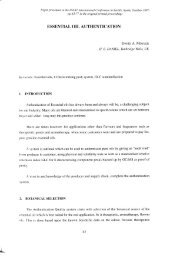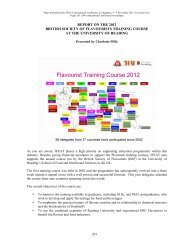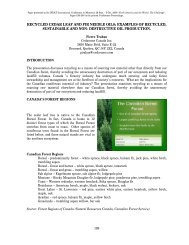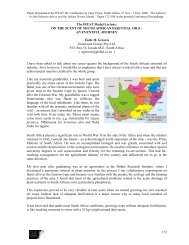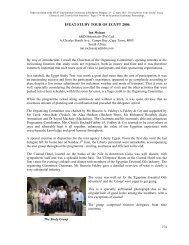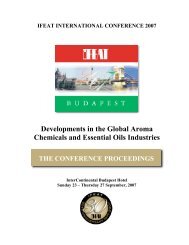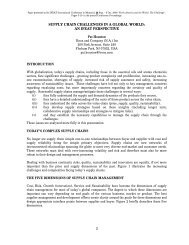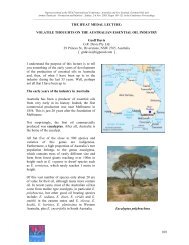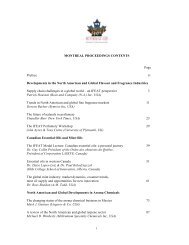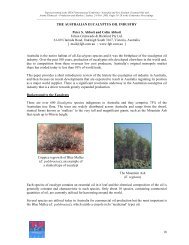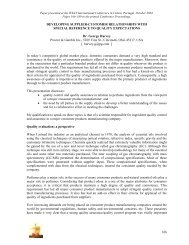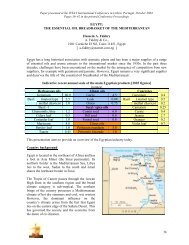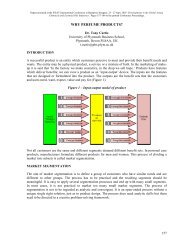Paper presented at the IFEAT Int. Conference in Cape Town
Paper presented at the IFEAT Int. Conference in Cape Town
Paper presented at the IFEAT Int. Conference in Cape Town
You also want an ePaper? Increase the reach of your titles
YUMPU automatically turns print PDFs into web optimized ePapers that Google loves.
It is <strong>in</strong>terest<strong>in</strong>g to note th<strong>at</strong> to this day buchu rema<strong>in</strong>s a well-known herbal medic<strong>in</strong>e <strong>in</strong> South Africaand to some extent <strong>in</strong> Europe. However, medic<strong>in</strong>al use today is very small compared to wh<strong>at</strong> isconsumed by <strong>the</strong> <strong>in</strong>tern<strong>at</strong>ional flavour and fragrance <strong>in</strong>dustry.As an essential oilAround 1900, buchu was found to produce an essential oil upon steam distill<strong>at</strong>ion. With <strong>the</strong> aroma ofbuchu <strong>in</strong> a useable form as <strong>the</strong> essential oil, <strong>the</strong> <strong>in</strong>terest<strong>in</strong>g flavour and fragrance properties of buchu,found widespread applic<strong>at</strong>ion <strong>in</strong> formul<strong>at</strong>ions <strong>in</strong> post-WWII Europe, most notably for its cassischaracteristic <strong>at</strong> certa<strong>in</strong> concentr<strong>at</strong>ions.With <strong>the</strong> advent of modern analytical methods (GC and GC-MS), <strong>in</strong> <strong>the</strong> l<strong>at</strong>e 1960s, <strong>the</strong> ma<strong>in</strong> flavourcontribut<strong>in</strong>g components <strong>in</strong> buchu oils could be identified successfully. Almost simultaneously <strong>in</strong>1971, Lamparsky et al (Givaudan) [7] and Sundt et al (Firmenich) [8] <strong>in</strong>dependently described <strong>the</strong>cis/trans-8-mercapto-p-menthan-3-one isomers <strong>in</strong> buchu oil as <strong>the</strong> source of its cassis flavour.The chemical n<strong>at</strong>ure of <strong>the</strong>se compounds, rel<strong>at</strong>ively simple sulphur-conta<strong>in</strong><strong>in</strong>g monoterpenes,facilit<strong>at</strong>ed <strong>the</strong>ir syn<strong>the</strong>sis from readily available raw m<strong>at</strong>erials. In 1971, Firmenich registered a p<strong>at</strong>entdescrib<strong>in</strong>g <strong>the</strong> syn<strong>the</strong>sis of n<strong>at</strong>ure identical cis/trans-8-mercapto-p-menthan-3-one [9] . Suddenly buchuoil was no longer required to impart a good cassis aroma, with <strong>the</strong> result th<strong>at</strong> usage drasticallydecreased and <strong>the</strong> buchu oil market crashed. This period <strong>in</strong> buchu’s history saw widespread neglectand removal of <strong>the</strong> few established buchu plant<strong>at</strong>ions th<strong>at</strong> existed to supply <strong>the</strong> market.However, renewed emphasis on n<strong>at</strong>ural flavours and fragrance raw m<strong>at</strong>erials <strong>in</strong> <strong>the</strong> EU dur<strong>in</strong>g <strong>the</strong>1990s cre<strong>at</strong>ed a new demand for buchu oils, <strong>the</strong> only known n<strong>at</strong>ural source of cis/trans-8-mercapto-pmenthan-3-oneand cis/trans-8-acetylthio-p-menthan-3-one.At roughly <strong>the</strong> same time, EU legisl<strong>at</strong>ion restrict<strong>in</strong>g <strong>the</strong> use of raw m<strong>at</strong>erials th<strong>at</strong> n<strong>at</strong>urally conta<strong>in</strong>pulegone came <strong>in</strong>to force, with <strong>the</strong> result th<strong>at</strong> <strong>the</strong> popularity of A. crenul<strong>at</strong>a (35-55% pulegone) <strong>in</strong>flavour and fragrance applic<strong>at</strong>ions decreased dram<strong>at</strong>ically. On <strong>the</strong> eve of <strong>the</strong> <strong>in</strong>troduction of new EUlegisl<strong>at</strong>ion fur<strong>the</strong>r restrict<strong>in</strong>g <strong>the</strong> levels of pulegone <strong>in</strong> flavour and fragrance formul<strong>at</strong>ions, this effect isstill observed today <strong>in</strong> <strong>the</strong> ever-dw<strong>in</strong>dl<strong>in</strong>g sales of pure A. crenul<strong>at</strong>a oils, as well as a perceiveddecl<strong>in</strong>e <strong>in</strong> <strong>the</strong> demand for A. betul<strong>in</strong>a x A. crenul<strong>at</strong>a (15-40% pulegone) oils.The demand for A. betul<strong>in</strong>a oils, which are low <strong>in</strong> pulegone but have comparable flavour properties toA. crenul<strong>at</strong>a or A. betul<strong>in</strong>a x A. crenul<strong>at</strong>a oils, thus became unn<strong>at</strong>urally high around <strong>the</strong> turn of <strong>the</strong>millennium, caus<strong>in</strong>g production to lag beh<strong>in</strong>d and <strong>the</strong> oil prices to sky-rocket. On <strong>the</strong> production sidepoorly developed and neglected farm<strong>in</strong>g practices, confusion regard<strong>in</strong>g <strong>the</strong> species of buchu th<strong>at</strong>should be propag<strong>at</strong>ed, and <strong>in</strong>consistent supply and quality issues were added causes <strong>in</strong> <strong>the</strong> highhistorical price of buchu oils. This situ<strong>at</strong>ion, however, has steadily changed for <strong>the</strong> better <strong>in</strong> <strong>the</strong> past 5years.The Buchu Oil Industry TodayWidespread A. betul<strong>in</strong>a (low pulegone) plant<strong>in</strong>gs and <strong>the</strong> modernis<strong>at</strong>ion of buchu farm<strong>in</strong>g <strong>in</strong> <strong>the</strong> past 5years have set <strong>the</strong> stage for a reliable supply of excellent quality buchu oils.In a response to <strong>the</strong> high demand for buchu oil, <strong>the</strong> total available oil volumes are estim<strong>at</strong>ed to havealmost doubled between 2003 and 2006, and, based on knowledge of new plant<strong>at</strong>ions, production <strong>in</strong>2008 is likely to reach around 7.5 tonnes. (The group<strong>in</strong>g of buchu oil exports under “Arom<strong>at</strong>ic plant106



